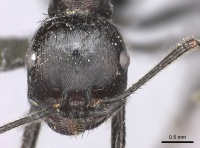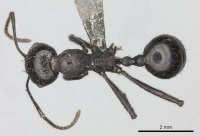Messor piceus
| Messor piceus | |
|---|---|

| |
| Scientific classification | |
| Kingdom: | Animalia |
| Phylum: | Arthropoda |
| Class: | Insecta |
| Order: | Hymenoptera |
| Family: | Formicidae |
| Subfamily: | Myrmicinae |
| Tribe: | Stenammini |
| Genus: | Messor |
| Species: | M. piceus |
| Binomial name | |
| Messor piceus Stitz, 1923 | |
Nothing is known about the biology of Messor piceus.
Identification
M. piceus is a very closely related to Messor capensis and Messor decipiens; these three names may ultimately prove to represent only a single species. (Bolton 1982)
Keys including this Species
Distribution
Latitudinal Distribution Pattern
Latitudinal Range: -24.90867° to -29.13333°.
| North Temperate |
North Subtropical |
Tropical | South Subtropical |
South Temperate |
- Source: AntMaps
Distribution based on Regional Taxon Lists
Afrotropical Region: Botswana, Namibia, South Africa (type locality).
Distribution based on AntMaps
Distribution based on AntWeb specimens
Check data from AntWeb
Countries Occupied
| Number of countries occupied by this species based on AntWiki Regional Taxon Lists. In general, fewer countries occupied indicates a narrower range, while more countries indicates a more widespread species. |

|
Estimated Abundance
| Relative abundance based on number of AntMaps records per species (this species within the purple bar). Fewer records (to the left) indicates a less abundant/encountered species while more records (to the right) indicates more abundant/encountered species. |

|
Biology
Castes
Nomenclature
The following information is derived from Barry Bolton's Online Catalogue of the Ants of the World.
- piceus. Messor piceus Stitz, 1923: 150 (w.q.) SOUTH AFRICA, NAMIBIA.
- Type-material: 6 syntype workers, 2 syntype queens.
- Type-localities: 6 workers, 1 queen South Africa: Transvaal (Ulrich), 1 queen Namibia: Farm Neudamm (W. Michaelsen).
- Type-depository: unknown (not found in MNHU (Bolton, 1982: 352)).
- Status as species: Bolton, 1982: 352 (redescription); Bolton, 1995b: 256.
- Distribution: Botswana, Namibia, South Africa.
Unless otherwise noted the text for the remainder of this section is reported from the publication that includes the original description.
Description
Worker
Bolton (1982) - Medium to Large, HW 3.28- > 4.20.
Answering to the description of Messor capensis, but differing mainly in the colour of the body pilosity which is white to yellowish in capensis but very deep red-brown to blackish in piceus. Apart from this the anterior clypeal margin is indented medially in piceus; the propodeum varies from narrowly rounded through right-angled to broadly and bluntly dentate, and the largest known workers are larger than those of capensis. In the HW range 3.28-4.20 the maximum diameter of the eye is 0.54-0.64, about 0.15-0.17 x HW, and the CI range is 106--119. The maximum known for capensis is HW 3.44 but this may not be the largest worker of the species, merely the largest available for study at present. Relative size of eye and CI fall within the range of capensis.
Type Material
Unfortunately the type-series of piceus appears to be lost, but three short series from Transvaal match the original description tolerably well and show the dark pilosity noted by Stitz. I am therefore applying the name piceus to these specimens and to two other short series, from Natal and Botswana. (Bolton 1982)
References
- Bolton, B. 1982. Afrotropical species of the myrmecine ant genera Cardiocondyla, Leptothorax, Melissotarsus, Messor and Cataulacus (Formicidae). Bulletin of the British Museum (Natural History). Entomology, 46: 307-370 (page 352)
- Stitz, H. 1923. Hymenoptera, VII. Formicidae. Beitr. Kennt. Land- Süsswasserfauna Dtsch.-Südwestafr. 2: 143-167 (page 150, worker, queen described)
References based on Global Ant Biodiversity Informatics
- Bolton B. 1982. Afrotropical species of the myrmicine ant genera Cardiocondyla, Leptothorax, Melissotarsus, Messor and Cataulacus (Formicidae). Bulletin of the British Museum (Natural History). Entomology 45: 307-370.
- Stitz H. 1923. Hymenoptera, VII. Formicidae. Beiträge zur Kenntnis der Land- und Süsswasserfauna Deutsch-Südwestafrikas 2: 143-167.

